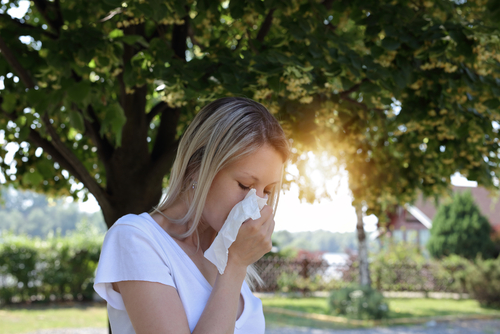As the temperatures rise during the Summer months, we move into the height of Pitta Season.
Too much Pitta (heat) in the body is the cause of many inflammatory conditions. Hay fever, red, itchy, inflamed skin (hives). Red, itchy eyes and acid indigestion.
According to Ayurveda, we are all made up of a combination of the 3 Doshas: Vata, Pitta and Kapha. Each Dosha holds specific qualities, which manifest in our mental and physical state. Everyone is a combination of the three doshas, but in different proportions, which gives every person their own unique physical and mental characteristics; just as Western science would describe a persons DNA or genetic code.
The qualities of Vata, Pitta and Kapha are a combination of two of the five great elements: ether (space), air, fire, water and earth. Understanding the characteristics of the three Doshas and how they physically and mentally present themselves can help people stay in balance (good health). You can read more about the Doshas here.
The characteristics of the Doshas can also be observed in food, our environment and the seasons. Pitta Dosha is a combination of the fire and water elements and has the following qualities: 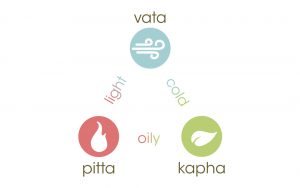
- Hot
- Oily
- Penetrating or sharp
- Light
- Posseses strong odour
- Liquid
- Mobile
According to Ayurveda ‘Like increases like and opposites create balance’. If we are predominantly pitta constitution, which a high percentage of us in the West are, the summer months are can increase our inherant Pitta, creating too much heat in the body and a multitude of inflammatory seasonal conditions.
Spotting the signs of Pitta Imbalance during the summer months:
- Hot, itchy skin rashes or hives.
- Hay fever (Pitta/Kapha disorder) : red itchy eyes. Inflamed nasal passages.
- Pitta type eczema: red, inflamed, itchy patches on the skin.
- Fever
- Hot feet at night
- Excess sweating, with unpleasant odour.
- Uncomfortable feeling of excess heat in the body.
- Acid reflux and indigestion.
- Diarrhea
- Emotionally you may feel angry, frustrate, dissatisfied, judgemental and overly competitive.
In addition, general signs of pitta disorder
- Inflammatory conditions
- Autoimmune diseases
- Excess heat in the body can cause hair loss
- Acne
How yo keep your cool during the Pitta season
Avoid sour, pungent and salty foods, all of which can increase pitta.
- Fermented foods such as hard cheese, bread made from yeast, and wine.
- Acidic and heating foods such as red meat and fish, vinegar and pickles, alcohol and caffeine. Some nuts e.g. peanuts, cashews and walnuts can also be heating.
- Pungent and heating vegetables: raw onions, leeks, chillies, radish, tomatoes, root vegetables
- Processed foods, deep fried, refined carbohydrates and sugar
- Pungent spices: cayenne pepper, sea salt, nutmeg, rosemary, bay leaf and chilli.
- Avoid too much strenuous exercise.
- Don’t skip meals. but keep meals nourishing and light.
Your Pitta pacifying diet for the summer months.
Think, light, green, wholesome foods, which will reduce internal heat, prevent inflammation, balance digestive fire, ground the body and absorb excess liquid and oil.
- Don’t skip breakfast. Start the day with a nourishing carbohydrate based breakfast. This doesn’t need to be breakfast cereal. You can use a variety of grains to make a breakfast porridge which can be eaten hot or cold. Suitable grains are: rice, quinoa, amaranth or oats. Cook with rice or coconut milk and add some flaxseeds. The proportions are approximately 1:3 grains to milk. To add an extra sweet, cooling element add cooling spices such as coriander seeds, cardamon, fennel, caraway and a pinch of turmeric.
- Avocado on toast: soda bread, sourdough, flat bread are all good options. Add a squeeze of lime juice a a little rock salt and pepper.
- Fruit salad with coconut shavings or coconut ‘yoghurt’. According to ayurveda there are several incompatible foods which should not be consumed together: fruit and yogurt is one of them, so substitute dairy yogurt for coconut yoghurt, which is also very cooling.
- Fruit is great. Just opt for sweet, cooling fruits: sweet apples, berries, cherries, dates, figs, lime, ripe mango and prunes. Again, add some coconut shavings.
- Raw food and salad is best consumed at lunchtime when the digestive fire is at its peak. Lots of green vegetables, with the addition of cooling grains: barley, rice, quinoa and pulses. Soaking and sprouting the pulses before hand will improve their digestibility.
Spouted mung dahl: Day 1 soak. Day 2 sprout. Day 3 cook and enjoy.
A little preparation is all that is needed. Soak beans overnight or approximately 8 hours.
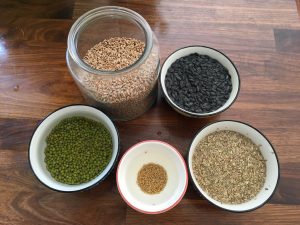
Day 1 Soak. Soak overnight or for approximately 8 hours.
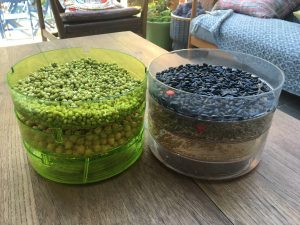
Day 2 Sprout
Day 2 Sprout
When the beans have spouted, fry off a combination of ground coriander seeds, cumin, nigella seeds, fresh ginger and garlic in a little ghee. Add the mung beans and water. Simmer for around 20-30mins. Serve with steamed green seasonal vegetables.
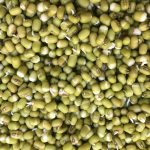
Mung beans sprouted for 1 day.
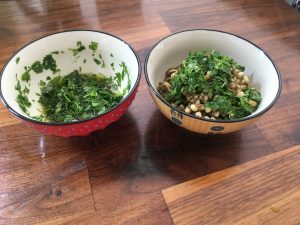
Day 3 Enjoy
Sprouted mung dahl is great served hot or cold. On it’s own or with the addition of steamed green veg for a cooling lunch or dinner.
Sprouted humous with herb oil.
Follow the same process for sprouting the chick peas.
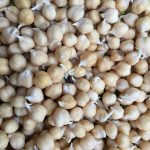
chick peas sprouted for 1 day.
Simmer the sprouted chick peas for around 30-40mins until soft. Heat a little ghee in a pan and add 1 tsp corianderseeds and 2-3 cloves of garlic, finely grated.
Sesame seeds and tahini can be quite heating so adding some ground coriander seeds will counteract the heating qualities of the tahini. Add the cooked chick peas and mash to your preferred consistency. Add the juice of a lime and olive oil, agin to your preferred consistency and taste. Add rock salt and black pepper to taste.
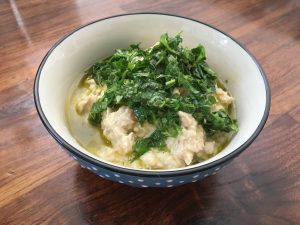
Sprouted Humous with Herb Oil
For the herb oil, I just used what was growing in my garden: parsley, lemon time and holy basil. Serve on top.
Follow the same theme for dinner, but go for lightly steamed green vegetables with white meat, pulses or grains.
Ayurvedic remedies to keep the fires of Pitta under control:
- Coriander water: 3 tsp lightly crushed coriander seeds soaked in a glass of water over night. Drink in the morning.
- To balance the digestive fire: 1/2 tsp black cumin (nigella seeds) dry roasted and ground wit honey, before meals. This remedy can be taken after meals to eliminate accumulated toxins from the body.
- Fennel tea. Infuse 1/2 tsp fennel seeds in water water and leave for 5 minutes before drinking.
- Cook with coconut milk which adds a cooling element to the diet.
- Stay cool by swimming or cool walks in the evening. Try to avoid strenuous exercise in the sun.
Hay fever remedies
- Turmeric has fantastic anti inflammatory properties. A pinch of turmeric can be consumed daily with honey or ghee. Add a little pippali if you suffer from mucus and nasal congestion.
- Tulsi (holy basil) can help rejuvenate the respiratory system. The dried leaves can be used to make tea or add fresh leaves to cooking.
Keeping the body cool
- Self Abayanga (massage) can help keep the body cool during the high pitta season. Coconut oil is a wonderful cooling oil which can be used to massage the body. If you suffer from hot feet at night, massage the feet with coconut oil before bed. Massaging the tummy can also help alleviate indigestion and remove toxins from the GI tract.
Stay cool everyone!!
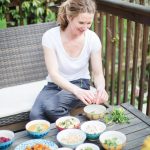 Clare Bannister is an Ayurvedic Nutrition and Lifestyle consultant, Ayurvedic Massage therapist, Yoga and Pilates teacher. If you would like to find out how Ayurveda and Yoga can help you maintain a balanced, healthy lifestyle please contact me.
Clare Bannister is an Ayurvedic Nutrition and Lifestyle consultant, Ayurvedic Massage therapist, Yoga and Pilates teacher. If you would like to find out how Ayurveda and Yoga can help you maintain a balanced, healthy lifestyle please contact me.
It’s more than a diet and exercise thing; it’s a ![]() thing!!
thing!!

